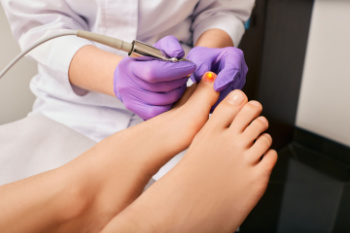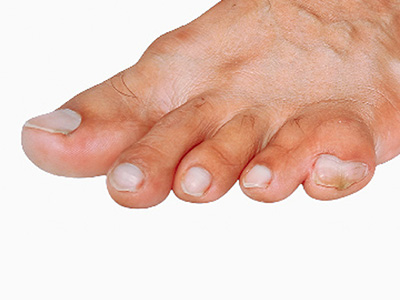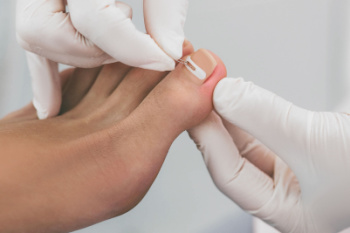Connect With Us
Blog
Items filtered by date: October 2024
Is Laser Treatment Effective for Toenail Fungus?

Toenail fungus, or onychomycosis, is a common condition that can be difficult to treat. Traditional conservative treatments, such as antifungal medications and topical solutions, often require lengthy durations and may not deliver satisfactory results. In contrast, toenail laser treatment offers a promising alternative. This innovative approach utilizes focused light to target and eliminate fungal organisms without damaging surrounding tissue. Clinical studies indicate that laser treatment can significantly reduce fungal presence and promote healthy nail regrowth more effectively than more conservative methods. Additionally, laser treatment typically involves fewer side effects and a shorter recovery time. While results may vary depending on the severity of the infection, many patients report improvement after just one or two sessions. For those struggling with persistent toenail fungus, laser treatment presents a compelling option to consider for achieving lasting results. If you have developed this unsightly condition, it is suggested that you consult a podiatrist who can determine if laser treatment is right for you.
Laser treatment can be an effective way to get rid of toenail fungus. If you have any questions about laser treatment, consult with Thomas Bobrowski, DPM from InStride Crystal Coast Podiatry. Our doctor will assess your condition and provide you with quality treatment for fungal nails.
What Are Toenail Fungal Infections?
Onychomycosis, or fungal infection of the nail, is a relatively common and non-serious condition. Around 10 percent of U.S. citizens are afflicted with fungal nails. Common forms of fungus that infect the nail include dermatophytes, yeasts, and molds.
Symptoms of Toenail Fungal Infections Include:
- Nail thickening
- Brittleness of the nail
- Discoloration of the nail
Diagnosis for Fungal Nails
Fungal infections are diagnosed by fungal culture and microscopy. This will rule out any other conditions such as nail trauma, psoriasis, lichen planus, and onychogryphosis.
What Is Laser Treatment?
Laser treatment is a non-invasive, safe, quick, and painless procedure that uses the heat from a laser to kill fungus in the nail. Each infected nail is targeted with a laser for several minutes. The treatment is usually utilized several different times over a select period. During this time, a podiatrist will keep an eye on the infection.
If you have any questions, please feel free to contact our office located in New Bern, NC . We offer the newest diagnostic and treatment technologies for all your foot care needs.
Preventing Foot and Ankle Injuries in Weight Lifting

Foot and ankle injuries are common in weight lifting, often resulting from improper technique, inadequate footwear, or insufficient foot strength. When lifting heavy weights, the feet play a critical role in providing stability and balance. Weak foot muscles can lead to misalignment, increasing the risk of sprains or strains. Strengthening the feet enhances overall stability, allowing for better control during lifts and reducing the chance of injury. Additionally, a strong foundation helps distribute weight evenly, alleviating stress on the ankles and preventing overuse injuries. Incorporating foot-strengthening exercises into a training routine, such as toe raises and resistance band movements, can significantly improve performance and reduce injury risk. Foot and ankle injuries often require a temporary pause from weight lifting to ensure proper healing. If you have sustained this type of injury, it is strongly suggested that you promptly consult a podiatrist who can offer effective treatment methods so you can return to weight lifting with ease.
Sports related foot and ankle injuries require proper treatment before players can go back to their regular routines. For more information, contact Thomas Bobrowski, DPM of InStride Crystal Coast Podiatry. Our doctor can provide the care you need to keep you pain-free and on your feet.
Sports Related Foot and Ankle Injuries
Foot and ankle injuries are a common occurrence when it comes to athletes of any sport. While many athletes dismiss the initial aches and pains, the truth is that ignoring potential foot and ankle injuries can lead to serious problems. As athletes continue to place pressure and strain the area further, a mild injury can turn into something as serious as a rupture and may lead to a permanent disability. There are many factors that contribute to sports related foot and ankle injuries, which include failure to warm up properly, not providing support or wearing bad footwear. Common injuries and conditions athletes face, including:
- Plantar Fasciitis
- Plantar Fasciosis
- Achilles Tendinitis
- Achilles Tendon Rupture
- Ankle Sprains
Sports related injuries are commonly treated using the RICE method. This includes rest, applying ice to the injured area, compression and elevating the ankle. More serious sprains and injuries may require surgery, which could include arthroscopic and reconstructive surgery. Rehabilitation and therapy may also be required in order to get any recovering athlete to become fully functional again. Any unusual aches and pains an athlete sustains must be evaluated by a licensed, reputable medical professional.
If you have any questions please feel free to contact our office located in New Bern, NC . We offer the newest diagnostic and treatment technologies for all your foot and ankle needs.
Causes and Treatment of Webbed Toes

Webbed toes, or syndactyly, occur when two or more toes are fused together due to incomplete separation during fetal development. This condition is largely congenital but in some cases can form without a known cause. Webbing can vary from a simple fusion of skin and soft tissue to a more complex connection involving bones or joints. Webbed toes do not always affect function or mobility, but surgical correction may be considered if there is pain, limited movement, or for cosmetic reasons. The surgical approach depends on the severity and type of fusion involved. Recovery may include casting and bracing to promote proper healing. A podiatrist can evaluate the extent of the toe webbing and provide guidance on surgical options if needed. Early intervention can ensure better outcomes and reduce potential complications. If your child has a toe deformity, it is suggested that you schedule an appointment with a podiatrist for treatment.
Congenital foot problems require immediate attention to avoid future complications. If you have any concerns, contact Thomas Bobrowski, DPM of InStride Crystal Coast Podiatry. Our doctor can provide the care you need to keep you pain-free and on your feet.
Congenital foot problems are deformities affecting the feet, toes, and/or ankles that children are born with. Some of these conditions have a genetic cause while others just happen. Some specific foot ailments that children may be born with include clubfeet, polydactyly/macrodactyly, and cleft foot. There are several other foot anomalies that can occur congenitally. What all of these conditions have in common is that a child may experience difficulty walking or performing everyday activities, as well as trouble finding footwear that fits their foot deformity. Some of these conditions are more serious than others. Consulting with a podiatrist as early as possible will help in properly diagnosing a child’s foot condition while getting the necessary treatment underway.
What are Causes of Congenital Foot Problem?
A congenital foot problem is one that happens to a child at birth. These conditions can be caused by a genetic predisposition, developmental or positional abnormalities during gestation, or with no known cause.
What are Symptoms of Congenital Foot Problems?
Symptoms vary by the congenital condition. Symptoms may consist of the following:
- Clubfoot, where tendons are shortened, bones are shaped differently, and the Achilles tendon is tight, causing the foot to point in and down. It is also possible for the soles of the feet to face each other.
- Polydactyly, which usually consists of a nubbin or small lump of tissue without a bone, a toe that is partially formed but has no joints, or an extra toe.
- Vertical talus, where the talus bone forms in the wrong position causing other bones in the foot to line up improperly, the front of the foot to point up, and the bottom of the foot to stiffen, with no arch, and to curve out.
- Tarsal coalition, when there is an abnormal connection of two or more bones in the foot leading to severe, rigid flatfoot.
- Cleft foot, where there are missing toes, a V-shaped cleft, and other anatomical differences.
- Macrodactyly, when the toes are abnormally large due to overgrowth of the underlying bone or soft tissue.
Treatment and Prevention
While there is nothing one can do to prevent congenital foot problems, raising awareness and receiving neonatal screenings are important. Early detection by taking your child to a podiatrist leads to the best outcome possible.
If you have any questions please feel free to contact our office located in New Bern, NC . We offer the newest diagnostic tools and technology to treat your foot and ankle needs.
Ankle Fractures That Call for Surgery

Severe ankle fractures often require surgery to restore stability and function. When a fracture affects the ankle in multiple areas, such as with bimalleolar or trimalleolar fractures, surgery is typically needed to properly realign the bones. Bimalleolar fractures involve injuries to both the inner and outer bones of the ankle. Trimalleolar fractures also include an injury to the back of the tibia near the ankle joint. These complex fractures lead to joint instability, making non-surgical treatment less effective. Symptoms like significant pain, swelling, and difficulty bearing weight often accompany these injuries. A podiatrist can diagnose the severity of an ankle fracture using imaging tools to determine if surgery is necessary to stabilize the ankle and prevent complications like arthritis. If you have severe ankle pain, it is suggested that you schedule an appointment with a podiatrist for a diagnosis and treatment.
Broken ankles need immediate treatment. If you are seeking treatment, contact Thomas Bobrowski, DPM from InStride Crystal Coast Podiatry. Our doctor can provide the care you need to keep you pain-free and on your feet.
Broken Ankles
A broken ankle is experienced when a person fractures their tibia or fibula in the lower leg and ankle area. Both of these bones are attached at the bottom of the leg and combine to form what we know to be our ankle.
When a physician is referring to a break of the ankle, he or she is usually referring to a break in the area where the tibia and fibula are joined to create our ankle joint. Ankles are more prone to fractures because the ankle is an area that suffers a lot of pressure and stress. There are some obvious signs when a person experiences a fractured ankle, and the following symptoms may be present.
Symptoms of a Fractured Ankle
- Excessive pain when the area is touched or when any pressure is placed on the ankle
- Swelling around the area
- Bruising of the area
- Area appears to be deformed
If you suspect an ankle fracture, it is recommended to seek treatment as soon as possible. The sooner you have your podiatrist diagnose the fracture, the quicker you’ll be on the way towards recovery.
If you have any questions, please feel free to contact our office located in New Bern, NC . We offer the newest diagnostic and treatment technologies for all your foot care needs.
Gout Pain Can Be Managed
Relief Options for Ingrown Toenails

Ingrown toenails occur when the nails grow into the surrounding skin, leading to pain, redness, and possible infection. While mild cases of ingrown toenails can sometimes improve on their own, more severe or persistent cases often require medical care. A podiatrist can assess the severity of the ingrown toenail and offer specific treatment options. In advanced cases, minor surgical procedures, such as partial or total nail removal, may be necessary to alleviate pain and prevent recurrence. Ingrown toenails that become infected may also be treated with antibiotics, if needed. Early intervention can reduce the likelihood of such complications, especially for patients with diabetes or circulation issues. Regular care from a podiatrist, such as learning how to correctly trim nails and wearing shoes that fit properly, can also help. If you have a painful ingrown toenail, it is suggested that you schedule an appointment with a podiatrist for an exam and treatment.
Ingrown toenails can become painful if they are not treated properly. For more information about ingrown toenails, contact Thomas Bobrowski, DPM of InStride Crystal Coast Podiatry. Our doctor can provide the care you need to keep you pain-free and on your feet.
Ingrown Toenails
Ingrown toenails occur when a toenail grows sideways into the bed of the nail, causing pain, swelling, and possibly infection.
Causes
- Bacterial infections
- Improper nail cutting such as cutting it too short or not straight across
- Trauma to the toe, such as stubbing, which causes the nail to grow back irregularly
- Ill-fitting shoes that bunch the toes too close together
- Genetic predisposition
Prevention
Because ingrown toenails are not something found outside of shoe-wearing cultures, going barefoot as often as possible will decrease the likeliness of developing ingrown toenails. Wearing proper fitting shoes and using proper cutting techniques will also help decrease your risk of developing ingrown toenails.
Treatment
Ingrown toenails are a very treatable foot condition. In minor cases, soaking the affected area in salt or antibacterial soaps will not only help with the ingrown nail itself, but also help prevent any infections from occurring. In more severe cases, surgery is an option. In either case, speaking to your podiatrist about this condition will help you get a better understanding of specific treatment options that are right for you.
If you have any questions please feel free to contact our office located in New Bern, NC . We offer the newest diagnostic and treatment technologies for all your foot and ankle needs.

